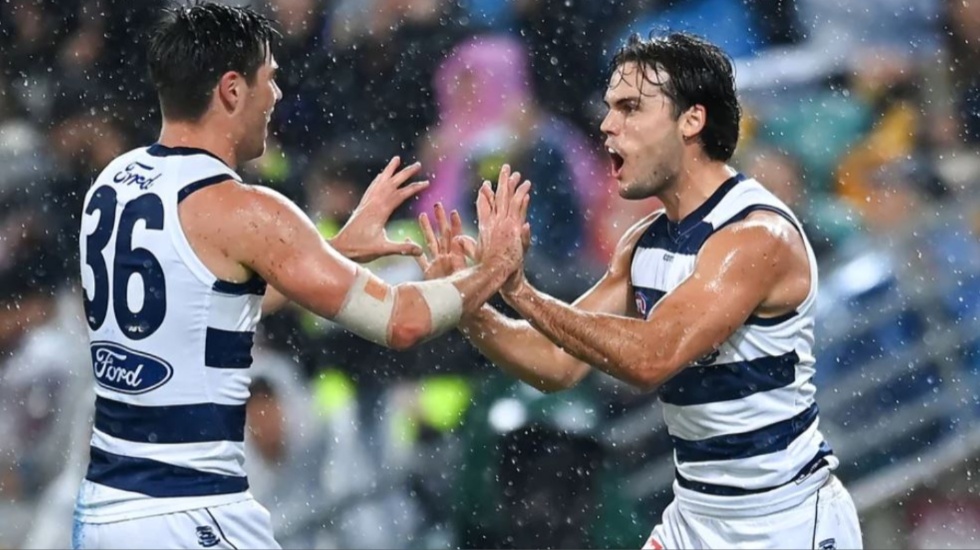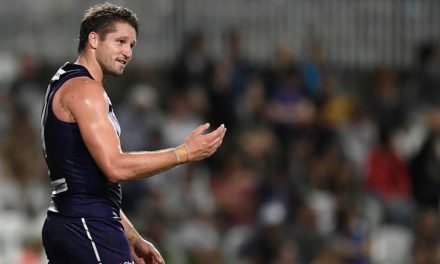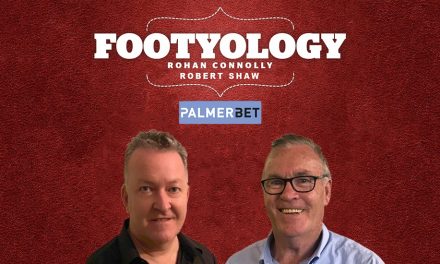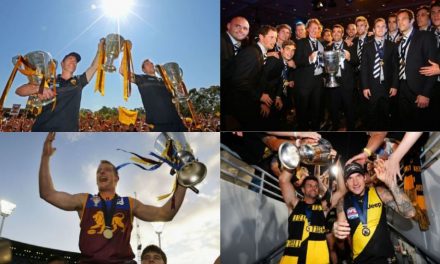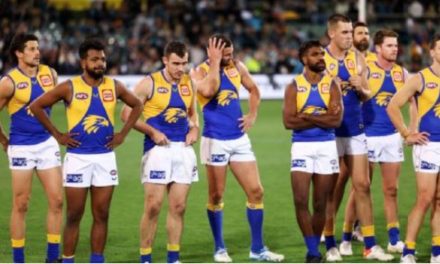Emerging Cats Ollie Henry (left) and Jack Bowes celebrate another Geelong goal against Brisbane. Photo: AFL MEDIA
It took seven weeks of football, but finally we have a meaningful AFL ladder, every team having played half-a-dozen games. What does it say? Well, mainly that some things don’t seem to change much. And by that, we mean Geelong being thereabouts.
The Cats have been up for the best part of two decades now, and after having last year missed finals for just the second time in 17 seasons, they’ve already as good ensured there won’t be a repeat of that anomaly in 2024, Geelong remaining the only undefeated team at 6-0.
More than that, though, it’s how the Cats clocked up that sixth victory which did the talking, knocking over Brisbane at the Gabba, these days nominally the most difficult ask in the competition, in the wettest, most difficult conditions imaginable.
Round 6 was a round of tests for some would-be top-of-the-ladder aspirants, and apart from Geelong, those sitting the exam flunked pretty badly.
Like Port Adelaide, which continues to disappoint at the worst possible moment after meticulously building up some credits.
The Power have a nasty habit of turning up their toes when things get a bit too difficult. We saw it in that infamous home preliminary final belting at the hands of the Western Bulldogs in 2021, we saw it in last year’s straight sets finals exit, and we saw it again on Saturday via a 73-point turnaround against Collingwood and a run of 13 Magpie goals to just three.
Greater Western Sydney didn’t fall off the perch to quite that extent against Carlton, but there were definite similarities in the Giants’ surrendering of a 20-point lead in the third quarter. From the 15-minute mark of that term to the three-quarter time siren, Carlton had 69 disposals to 31, won contested ball 25-14, and booted 6.1 from just 10 inside 50s.
Gold Coast, not for the first time, didn’t turn up for the start of an away game against Sydney for which it should have been more than souped-up. It clawed back some of the deficit, then tuned out a second time, conceding seven goals in the third quarter, the contest effectively over by then.
As for Fremantle, how do you even call a test a game against the reigning wooden-spooner, 16th on the ladder prior to the round? By rights, for the Dockers it should have been a stroll. Which is what they appeared to believe also, hence an embarrassing 37-point derby defeat.
The Power, Giants, Suns and Dockers are four teams with whom you would never feel anything better than very anxious playing for keeps. And that reliability is perhaps the single biggest difference between Geelong and its rivals. It’s certainly been a key to Geelong’s success for so long now.
PLEASE HELP US CONTINUE TO THRIVE BY BECOMING AN OFFICIAL FOOTYOLOGY PATRON. JUST CLICK THIS LINK.
Even when the Cats finished 12th last season with only 10-and-a-half wins, they weren’t too far off the pace. None of their 12 defeats were by any more than 38 points, and only two were by more than 29 points. Yet, like a lot of my peers, I couldn’t find a spot for them in my predicted top eight, settling on ninth. That already looks like a significant underestimation.
There are so many impressive aspects to the operation that is the Geelong Football Club, but is there any more outstanding than its junior development? It’s been the key to keeping the Cats both consistently competitive yet capable simultaneously of regeneration.
And we won’t see many better examples of it at work than in Saturday night’s win over Brisbane in the wet.
The keys to this Geelong performance were the likes of Max Holmes, Zach Guthrie, Tanner Bruhn, Tyson Stengle, Jack Bowes, Gryan Miers and Brandan Parfitt. That collection of names have arrived at Kardinia Park via a variety of sources, some trade-ins, some early draft picks, some not so.
But the common denominator is all are now significantly better and more consistent players than when they arrived at the club.
Who realistically would have believed Stengle could ever deliver consistently the form of which he was capable after his experiences at Richmond and Adelaide, let alone earn All-Australian selection and be such an important part of a premiership?
How many clubs might have run out of patience with Cam Guthrie’s less-heralded younger brother, now also a premiership player and a fourth-place getter in a best and fairest? Or Parfitt, who like Guthrie, is now in his eighth season of senior football?
Geelong shows more faith in its list than most, and why not? The consistency with which the Cats get it right not just picking the right talent, but getting it to eventually deliver the best it possibly can, means their system will prevail far more often than not.
And the added strength of that system is that those players can continue to make meaningful contributions even as they are getting to that stage, so well-defined and clearly understood are the roles within that structure coach Chris Scott expects them to play.
We haven’t seen a dependability like Geelong’s as a club and football team since Hawthorn dominated football in the 1980s. And even the Hawks of that era (many of whom are still involved with the game professionally) would admit that sustained excellence and premierships are harder to achieve and to win now than then.
Are the Cats on their way to another flag? It’s still early days, obviously, and there’s a big few weeks ahead with games against Carlton, Melbourne, Port Adelaide, Gold Coast and GWS in succession.
But there are definite 2022 vibes about this version. And put it this way; is there any team currently you’d rather have playing for your life than the Cats? I don’t think so.
This article first appeared at ESPN.

